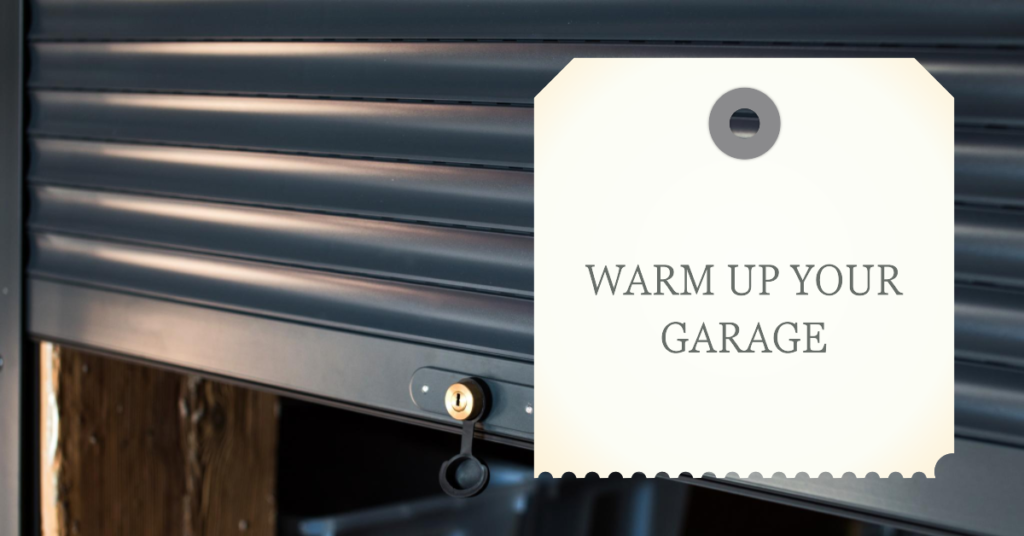With winter fast approaching, finding the right solution to keep your garage warm and cozy is crucial. A well-heated garage not only provides a comfortable space for DIY projects but also protects your tools, equipment, and vehicles from freezing temperatures.
With various heating options available – such as infrared heaters, electric heaters, propane heaters, and wood-burning stoves – selecting the perfect system can be overwhelming.
In this blog post, we’ll guide you through different types of garage heaters and share valuable tips on how to efficiently heat your space while keeping energy costs low.
Key Takeaways
- There are various types of garage heaters to choose from, including electric heaters, forced-air heaters, radiant heaters, wood or pellet stoves, and propane heaters. Consider factors like heating capacity and efficiency, power source and energy efficiency, garage size and insulation levels when selecting a suitable heating system.
- Proper insulation is crucial in keeping your garage warm during winter. Insulate walls and ceilings with foam boards or fiberglass batts to retain heat inside the space effectively.
- Sealing doors and windows helps prevent cold air drafts from entering your garage. Using a programmable thermostat for efficient temperature regulation can save on energy costs while circulating warm air with fans ensures optimal heat distribution throughout the space.
Types Of Garage Heaters
Garages can be heated using a variety of heating systems, including electric heaters, forced air heaters, radiant heaters, wood or pellet stoves, and propane heaters.
Electric Heaters
Electric heaters are a popular and convenient choice for heating garages, as they come in various styles and sizes, fitting different spaces and requirements. One example is the compact 120-volt portable plug-in heater, perfect for small garage spaces that need occasional heating.
Opting for electric heaters not only ensures a reliable heat source but also offers enhanced safety compared to combustion-based alternatives. For instance, ceramic air heaters can efficiently warm up your garage by evenly distributing heated air like fan-forced heaters without producing hazardous fumes or requiring ventilation.
Forced Air Heaters
Forced-air heaters are a popular choice for garage heating systems due to their ability to quickly and effectively heat large areas. These heaters use a fan-forced system to distribute warm air throughout the garage, helping to maintain a comfortable temperature during the colder months.
One advantage of forced-air heaters is that they come in different sizes, making it easy to select one that matches your garage’s size and insulation level. They’re also relatively affordable compared to other heating options such as radiant floor heating or mini-split heat pumps.
Radiant Heaters
Radiant heaters are an excellent option for heating a garage. They work by emitting electromagnetic waves that heat up objects and people in their path, rather than just the air surrounding them.
Radiant heaters are typically more energy-efficient than traditional forced-air heaters because they don’t waste energy warming up the air before distributing it around the room.
When shopping for radiant heaters, consider looking for models that come with adjustable thermostats or timers so you can control how much heat is generated and when it’s turned on.
Some popular options include electric infrared heaters that mount directly onto ceilings or walls, which help save floor space while providing reliable warmth; propane radiant heaters that offer fast-starting ignition systems and easy-to-move designs; or ceramic tile-floor mats specifically engineered for rapid heat transfer to provide high-efficiency all-around warmth throughout your garage workspace.
Wood Or Pellet Stoves
If you’re looking for an alternative way to heat your garage that doesn’t require electricity, consider using a wood or pellet stove. These stoves are fueled by either firewood or compressed pellets made from sawdust and other materials.
One advantage of using a wood or pellet stove is that they provide sustained heat even after the fire has gone out. This means that you won’t have to worry about constant fueling throughout the day, allowing you to work in comfort all day long.
Of course, one downside is the need for regular cleaning and maintenance of the stove itself. You will also need proper ventilation installed in your garage to ensure the safe operation of your stove.
Propane Heaters
Propane heaters are an excellent option for heating garages that lack electrical wiring or where natural gas is unavailable. They can be either vented or unvented, and both types operate using propane gas to create heat.
Vented propane garage heaters draw air from outside and release exhaust gases through a pipe system, making them the safer choice as they prevent carbon monoxide buildup inside your garage.
Unvented propane heaters are known to produce moisture and harmful combustion byproducts when burned and require proper ventilation. Propane heaters come in various sizes, ranging from portable units that work well for small garages to wall-mounted ones designed for more extensive spaces.
Factors To Consider When Choosing A Garage Heater
Consider the heating capacity and efficiency, power source and energy efficiency, garage size and insulation, as well as safety features when choosing a garage heater.
Heating Capacity And Efficiency
It’s important to choose the right garage heater based on its heating capacity and efficiency. Heating capacity refers to how much heat the heater can produce, while efficiency involves how effectively it uses energy.
For instance, if you have a large garage that is poorly insulated, you may need a high-capacity forced air or radiant heater for efficient heating. However, if you have a small workspace with good insulation already in place, an electric space heater with adjustable settings may be all you need to keep warm during winter months.
Power Source And Energy Efficiency
One of the essential factors to consider when heating your garage is the power source and energy efficiency of your chosen heating system. The type of fuel or electricity needed can have a significant impact on how efficient and cost-effective your garage heater will be.
For instance, electric heaters are generally more energy-efficient than propane heaters for small spaces.
It’s also important to note that not all heating systems operate at the same level of efficiency. Radiant floor heating, mini-split heat pumps, and infrared heaters are some examples of highly efficient garage heating options.
In comparison, older space heaters may consume more energy without providing sufficient warmth in poorly insulated garages.
Garage Size And Insulation
The size of your garage and the quality of insulation in place play a key role in determining which heating option is best for your space. Larger garages, especially those with high ceilings or poor insulation, require more powerful heating sources to maintain warmth.
Proper insulation is also important as it helps retain heat within the garage and prevents energy loss. This can be achieved by insulating walls and ceilings, sealing doors and windows to prevent drafts, installing weatherstripping around door frames, and adding insulation to the garage door if needed.
Safety Features
Garage heaters can be dangerous if they don’t have the proper safety features in place. When choosing a garage heater, it’s important to look for models that come equipped with built-in safety mechanisms such as overheat protection and automatic shut-off switches.
Overheat protection is crucial because it prevents the heater from getting too hot and causing a fire or other damage to your garage.
Some garage heaters also have cool-touch exteriors or grilles that stay cool even when the unit is heating up, which reduces the chance of burns or accidental contact with the hot surface.
Overall, safety should always be a top priority when considering different types of garage heating options.
Heating Options For Your Garage
Heating options for your garage include infrared heaters, mini-split heat pumps, radiant floor heating, and direct-vent space heaters.
Infrared Heaters
Infrared heaters are a popular option for heating garages as they use electromagnetic radiation to heat objects directly, rather than just the air. This makes them more energy-efficient and quicker to heat up the space compared to traditional forced-air heaters.
Infrared heaters come in different types like wall-mounted or freestanding models and can be powered by electricity or propane gas. One of the best things about infrared heaters is that they don’t produce any fumes or odors, making them ideal for enclosed spaces like garages.
It’s important to note that while infrared heaters work well at heating specific areas within a garage, they may not be enough on their own in extremely cold temperatures.
Mini-Split Heat Pumps
Mini-Split Heat Pumps are another efficient option for heating a garage in the winter. These systems work by absorbing heat from outside and transferring it indoors, providing a controlled and comfortable temperature.
One advantage of mini-split heat pumps is that they can be used for both heating and cooling purposes, making them a year-round solution. They also have energy-saving features like programmable thermostats that allow you to control their output based on your usage patterns.
Radiant Floor Heating
Radiant floor heating is a type of garage heater that heats the space from the ground up. This system uses water pipes or electric coils installed under the concrete floor to provide heat, making it an efficient and comfortable option for heating your garage.
One advantage of radiant floor heating is that it operates quietly and has no visible components. It also provides better energy efficiency since it does not rely on forced hot air that can easily escape through doors and windows.
However, installing radiant floor heating requires professional assistance, as it involves demolishing existing flooring to install electrical wiring or water pipes beneath the surface.
Direct-Vent Space Heaters
Direct-vent space heaters are an excellent option for heating garages, especially those without a lot of insulation. These heaters operate on natural gas or propane and require venting to release exhaust fumes safely.
Direct-vent space heaters offer more efficiency than other combustion-powered options because they draw in fresh air from outside while venting exhaust gases out.
With proper installation, direct-vent space heaters can provide efficient heat output that is perfect for keeping your garage warm and comfortable during the winter months.
They are well-suited to larger garages or workshops with ample ceiling height where hot air naturally rises to create a convection cycle that evenly distributes heat throughout the space.
Tips For Efficiently Heating Your Garage
Seal any gaps or cracks in your garage, insulate walls and ceilings, use a programmable thermostat to regulate temperature, circulate warm air with fans, and consider alternative heating methods like infrared heaters for an efficient garage heating system.
Seal Doors And Windows
One essential factor to consider when heating your garage is keeping the warm air inside. Sealing all doors and windows ensures that cold drafts do not enter, which can cause heat loss in the space.
This step may seem obvious, but it is surprising how many people overlook it. Inspect your garage’s windows and doors for gaps, cracks or holes where air might leak out or come in.
Adding insulation to the walls and ceiling will further help keep warmth from escaping into the surrounding air. Properly sealed garages are easier to keep warm than poorly insulated ones because they don’t allow cold draughts of winter air from entering, making it more energy-efficient to maintain heat inside.
Insulate Walls And Ceilings
One crucial factor to consider when heating your garage is insulation. Most garages lack proper insulation, causing significant heat loss through walls and ceilings. Adding insulation can help trap the heat inside, making it easier and more cost-efficient to maintain a warm temperature.
You can insulate your garage by installing foam boards or fiberglass batts in the walls and ceiling.
Fun fact – did you know that an uninsulated attached garage can account for up to 25% of a home’s total heat loss? By properly insulating your garage, you not only increase its comfort level but also save on energy costs in the long run.
Use A Programmable Thermostat
A programmable thermostat is a great addition to any garage heating system. It allows you to control the temperature on a set schedule, so you can keep your garage warm when you need it and save energy when you don’t.
For example, if you typically only use your garage in the evenings or weekends, you can program the thermostat to lower the heat during the day when no one is there.
One popular option for a programmable thermostat is Nest Learning Thermostat. This smart device learns from your patterns and adjusts itself accordingly, even allowing remote access through an app on your smartphone or tablet.
Circulate Warm Air With A Fan
To distribute heat throughout your garage, it’s essential to circulate warm air. One of the most effective ways to do this is by using a fan. A ceiling or floor-mounted fan can help move hot air around and prevent it from collecting in one area.
Moreover, you could use an oscillating fan that blows hot air directly onto your workbench or specific areas where you need warmth the most. By doing so, you’ll reduce energy loss because you won’t have to heat up all areas uniformly.
Consider Alternative Heating Methods
Aside from electric, forced air, and radiant garage heaters, there are other alternative heating methods to keep your garage warm during the cold winter months. One option is installing a mini-split heat pump that can both cool and heat your garage space efficiently.
Another option is using radiant floor heating, which provides consistent warmth by radiating heat from the ground up.
For DIYers or those without access to electricity, wood stoves can be used for heating a detached garage. Propane heaters are another alternative fuel source that can effectively provide instant warmth in an uninsulated garage space.
Regardless of which alternative method you choose for your garage heating needs, it’s essential to evaluate factors such as energy efficiency, safety features and cost-effectiveness before making a final decision.
Conclusion
In conclusion, there are many options for heating your garage during the cold winter months. From electric heaters to wood stoves and mini-split heat pumps, choosing the right heating system depends on various factors such as garage size, insulation, and energy efficiency.
Remember to seal doors and windows, insulate walls and ceilings, use a programmable thermostat, circulate warm air with a fan, and consider alternative heating methods for optimal efficiency in keeping your garage warm.
FAQs:
1. What are my options for heating a garage?
Common options for heating a garage include electric heaters, propane or natural gas heaters, wood stoves, and radiant floor heating.
2. How do I choose the right size heater for my garage?
The size of your heater will depend on various factors like the size of your garage, insulation level, ceiling height and desired temperature range. Consult with a professional to determine the appropriate heater size for your space.
3. Can I use an electric space heater to heat my garage?
An electric space heater can be used to heat a small area of a garage but may not be sufficient enough to warm up larger spaces. It’s important to ensure any electrical appliance used in the garage is safe from water exposure and properly grounded.
4. Is it cost-effective to install radiant floor heating in my garage?
Radiant floor heating system can provide consistent warmth throughout your entire room without using noisy fans or cumbersome ductwork; they’re also energy-efficient which can lead you towards saving money over time compared with other methods such as traditional forced-air systems. However installing this type of system could be costly as it requires installation by professionals familiar with plumbing and wiring principles involved in setting up these types of systems making best suited option if planning permanent conversions rather than temporary fixes.
Related Posts
How to get rid of flies in garage
How to cool a garage
How to get rid of mice in garage
How to lubricate a garage door
How to clean garage floor
How much to epoxy garage floor
How to paint garage door
Why do garage doors open by themselves







